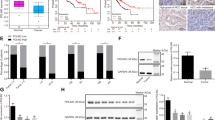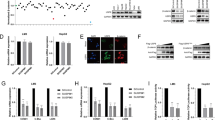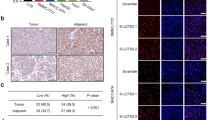Abstract
The peptidyl-proplyl-isomerase, PIN1, upregulates β-catenin by inhibiting its interaction with APC. β-catenin accumulation occurs in about 70% of hepatocellular carcinoma (HCC), of which only 20% are due to β-catenin mutations. The role of PIN1 in β-catenin upregulation in HCC was investigated. PIN1 was shown to be overexpressed in more than 50% of HCC. All cases with PIN1 overexpression also showed β-catenin accumulation, with 68% of cases showing concomitant β-catenin and cyclin D1 accumulation. PIN1 was shown to contribute to β-catenin and cyclin D1 overexpression directly by in vitro cell-line transfection experiments. Finally, we showed that PIN1 overexpression and β-catenin gene mutations appeared to be mutually exclusive events, leading to β-catenin accumulation in HCC. These results showed that PIN1 overexpression leading to β-catenin accumulation might be a critical event in hepatocarcinogenesis, and that PIN1 is a potential target for therapeutic intervention in HCC.
This is a preview of subscription content, access via your institution
Access options
Subscribe to this journal
Receive 50 print issues and online access
$259.00 per year
only $5.18 per issue
Buy this article
- Purchase on Springer Link
- Instant access to full article PDF
Prices may be subject to local taxes which are calculated during checkout



Similar content being viewed by others
References
Aberle H, Bauer A, Stappert J, Kispert A and Kemler R . (1997). EMBO J., 16, 3797–3804.
Brown JJ, Parashar B, Moshage H, Tanaka KE, Engelhardt D, Rabbani E, Roy-Chowdhury N and Roy-Chowdhury J . (2000). Hepatology, 31, 173–181.
Chen TC, Hsieh LL, Ng KF, Jeng LB and Chen MF . (1998). Cancer Lett., 134, 23–28.
de La Coste A, Romagnolo B, Billuart P, Renard CA, Buendia MA, Soubrane O, Fabre M, Chelly J, Beldjord C, Kahn A and Perret C . (1998). Proc. Natl. Acad. Sci. USA, 95, 8847–8851.
Deane NG, Parker MA, Aramandla R, Diehl L, Lee WJ, Washington MK, Nanney LB, Shyr Y and Beauchamp RD . (2001). Cancer Res., 61, 5389–5395.
He TC, Sparks AB, Rago C, Hermeking H, Zawel L, da Costa LT, Morin PJ, Vogelstein B and Kinzler KW . (1998). Science, 281, 1438–1441.
Huang H, Fujii H, Sankila A, Mahler-Araujo BM, Matsuda M, Cathomas G and Ohgaki H . (1999). Am. J. Pathol., 155, 1795–1801.
Ihara A, Koizumi H, Hashizume R and Uchikoshi T . (1996). Hepatology, 23, 1441–1447.
Ikeda S, Kishida S, Yamamoto H, Murai H, Koyama S and Kikuchi A . (1998). EMBO J., 17, 1371–1384.
Joo M, Kang YK, Kim MR, Lee HK and Jang JJ . (2001). Liver, 21, 89–95.
Kitagawa M, Hatakeyama S, Shirane M, Matsumoto M, Ishida N, Hattori K, Nakamichi I, Kikuchi A and Nakayama K . (1999). EMBO J., 18, 2401–2410.
Liou YC, Ryo A, Huang HK, Lu PJ, Bronson R, Fujimori F, Uchida T, Hunter T and Lu KP . (2002). Proc. Natl. Acad. Sci. USA, 99, 1335–1340.
Manickan E, Satoi J, Wang TC and Liang TJ . (2001). J. Biol. Chem., 276, 13989–13994.
Miyoshi Y, Iwao K, Nagasawa Y, Aihara T, Sasaki Y, Imaoka S, Murata M, Shimano T and Nakamura Y . (1998). Cancer Res., 58, 2524–2527.
Morin PJ, Sparks AB, Korinek V, Barker N, Clevers H, Vogelstein B and Kinzler KW . (1997). Science, 275, 1787–1790.
Nishida N, Fukuda Y, Komeda T, Kita R, Sando T, Furukawa M, Amenomori M, Shibagaki I, Nakao K, Ikenaga M and Ishizaki K . (1994). Cancer Res., 54, 3107–3110.
Ryo A, Liou YC, Lu KP and Wulf G . (2003). J. Cell Sci., 116, 773–783.
Ryo A, Liou YC, Wulf G, Nakamura M, Lee SW and Lu KP . (2002). Mol. Cell. Biol., 22, 5281–5295.
Ryo A, Nakamura M, Wulf G, Liou YC and Lu KP . (2001). Nat. Cell Biol., 3, 793–801.
Santoni-Rugiu E, Jensen MR and Thorgeirsson SS . (1998). Cancer Res., 58, 123–134.
Shtutman M, Zhurinsky J, Simcha I, Albanese C, D’Amico M, Pestell R and Ben-Ze’ev A . (1999). Proc. Natl. Acad. Sci. USA, 96, 5522–5527.
Taniguchi K, Roberts LR, Aderca IN, Dong X, Qian C, Murphy LM, Nagorney DM, Burgart LJ, Roche PC, Smith DI, Ross JA and Liu W . (2002). Oncogene, 21, 4863–4871.
Wong CM, Fan ST and Ng IO . (2001). Cancer, 92, 136–145.
Wulf GM, Ryo A, Wulf GG, Lee SW, Niu T, Petkova V and Lu KP . (2001). EMBO J., 20, 3459–3472.
Zhang YJ, Jiang W, Chen CJ, Lee CS, Kahn SM, Santella RM and Weinstein IB . (1993). Biochem. Biophys. Res. Commun., 196, 1010–1016.
Acknowledgements
We thank Dr J Liang at the National Institute of Health, USA for providing the albumin promoter plasmid and Dr J Roy-Chowdhury at Albert Einstein College of Medicine, USA for providing the nontumorigenic liver cell line. This work was supported by a grant from Kadoorie Charitable Foundation, Hong Kong to YLK.
Author information
Authors and Affiliations
Corresponding authors
Rights and permissions
About this article
Cite this article
Pang, R., Yuen, J., Yuen, M. et al. PIN1 overexpression and β-catenin gene mutations are distinct oncogenic events in human hepatocellular carcinoma. Oncogene 23, 4182–4186 (2004). https://doi.org/10.1038/sj.onc.1207493
Received:
Revised:
Accepted:
Published:
Issue Date:
DOI: https://doi.org/10.1038/sj.onc.1207493
Keywords
This article is cited by
-
Depletion of mitochondrial methionine adenosyltransferase α1 triggers mitochondrial dysfunction in alcohol-associated liver disease
Nature Communications (2022)
-
Overexpression of Pin1 and rho signaling partners correlates with metastatic behavior and poor recurrence-free survival of hepatocellular carcinoma patients
BMC Cancer (2019)
-
Pin1 impairs microRNA biogenesis by mediating conformation change of XPO5 in hepatocellular carcinoma
Cell Death & Differentiation (2018)
-
MicroRNA-140-5p inhibits hepatocellular carcinoma by directly targeting the unique isomerase Pin1 to block multiple cancer-driving pathways
Scientific Reports (2017)
-
Chemical or genetic Pin1 inhibition exerts potent anticancer activity against hepatocellular carcinoma by blocking multiple cancer-driving pathways
Scientific Reports (2017)



